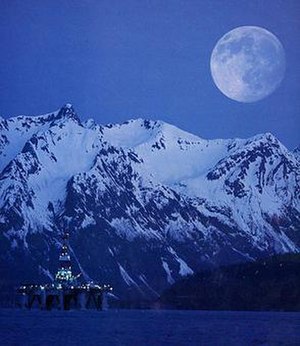Ocean Ranger

Ocean Ranger drilling in the Gulf of Alaska, off Yakutat in southeast Alaska, with Mt. St. Elias, second highest peak in North America and just over the Alaskan border in Canada, and a full moon, as backdrop.
|
|
| History | |
|---|---|
| Name: | Ocean Ranger |
| Owner: | ODECO |
| Operator: | ODECO |
| Builder: | Mitsubishi Heavy Industries's Yard in Hiroshima, Japan |
| Yard number: | 615641 |
| Launched: | 1976 |
| Christened: | 1976 |
| Completed: | 1976 |
| Acquired: | 1976 |
| Maiden voyage: | 1976 |
| In service: | 1976–1982 |
| Out of service: | 15 February 1982 |
| Fate: | Sank in storm |
| General characteristics | |
| Class and type: | semi-submersible mobile offshore drilling unit |
| Tonnage: | 25,000 |
| Length: | 396 ft (121 m) |
| Beam: | 262 ft (80 m) |
| Height: | 337 ft (103 m) |
| Draught: | 79 ft (24 m) |
| Draft: | 151.6 ft (46.2 m) |
| Decks: | 2 |
| Installed power: | 7000 hp |
| Propulsion: | 2 x 3500HP DC Electric motors providing propulsion to 2 Steerable Kort Nozzles |
| Capacity: | 100 |
| Crew: | 84 |
| Notes: | raised and sunk in deeper waters |
Ocean Ranger was a semi-submersible mobile offshore drilling unit that sank in Canadian waters on 15 February 1982. It was drilling an exploration well on the Grand Banks of Newfoundland, 267 kilometres (166 mi) east of St. John's, Newfoundland, for Mobil Oil of Canada, Ltd. (MOCAN) with 84 crew members on board when it sank. There were no survivors.
Ocean Ranger was designed and owned by Ocean Drilling and Exploration Company, Inc. (ODECO) of New Orleans. The vessel was a self-propelled large semi-submersible design with a drilling facility and living quarters. It was capable of operation beneath 1,500 feet (460 m) of ocean water and could drill to a maximum depth of 25,000 feet (7,600 m). It was described by ODECO as the world's largest semi-submersible oil rig to date.
Constructed for ODECO in 1976 by Mitsubishi Heavy Industries in Hiroshima, Japan, Ocean Ranger was 396 feet (121 m) long, 262 feet (80 m) wide, and 337 feet (103 m) high. It had twelve 45,000-pound (20,000 kg) anchors. The weight was 25,000 tons. It was floating on two 122-metre (400 ft) long pontoons that rested 24 metres (79 ft) below the surface.
The vessel was approved for 'unrestricted ocean operations' and designed to withstand extremely harsh conditions at sea, including 100-knot (190 km/h) winds and 110-foot (34 m) waves. Prior to moving to the Grand Banks area in November 1980, it had operated off the coasts of Alaska, New Jersey and Ireland.
On 26 November 1981, Ocean Ranger commenced drilling well J-34, its third well in the Hibernia Oil Field. Ocean Ranger was still working on this well in February 1982 when the incident occurred. Two other semi-submersible platforms were also drilling nearby: Sedco 706, 8.5 miles (13.7 km) NNE, and Zapata Ugland, 19.2 miles (30.9 km) N of Ocean Ranger. On 14 February 1982, the platforms received reports of an approaching storm linked to a major Atlantic cyclone from NORDCO Ltd, the company responsible for issuing offshore weather forecasts. The usual method of preparing for bad weather involved hanging-off the drillpipe at the sub-sea wellhead and disconnecting the riser from the sub-sea blowout preventer. Due to surface difficulties and the speed at which the storm developed, the crew of Ocean Ranger were forced to shear the drillpipe after hanging-off, after which they disconnected the riser in the early evening.
...
Wikipedia
